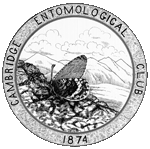
| January 2008: Psyche has a new publisher, Hindawi Publishing, and is accepting submissions |
Article beginning on page 4.
Psyche 15:4-5, 1908.
Full text (searchable PDF)
Durable link: http://psyche.entclub.org/15/15-004.html
The following unprocessed text is extracted from the PDF file, and is likely to be both incomplete and full of errors. Please consult the PDF file for the complete article.
PSYCHE
[February
TWO NEW MUTILLIDAE FROM COLORADO.
BY T. D. A. COCKERELL AND 8. A. ROEWER.
Ephuta spawijorntis n. sp.
Q .
Length 105121 mm.; head round, not quite as wide as thorax; scape with large deep punctures; first joint of flagellum not so long as 2+3; mandibles strongly tridentate; thorax moderately elongate, narrowed behind; coxse, trochanters and femora with strong punctures; four posterior tibiae with robust black spines; head and thorax with large, deep, dense punctures, those on the face not so deep, those on the posterior face of metathorax somewhat elongate; first abdominal segment sessile on second; its ventral carina evident, terminating abruptly, but neither bifid nor with a terminal tooth; pygidium longitudinally striated on upper two-thirds, the lower third minutely roughened; abdomen punctured in the same general manner as the thorax, but the punctures on second segment elongate. Color bright ferruginous; with the antennae, legs, base and apex of second abdominal segment (the apex narrowly, wider in the middle), and the segments after the second, all black; face below antennae, and first abdominal segment dark rufous; mandibles black apically, rufous basally; vertex, face, thorax above and second abdominal segment with appressed golden-red pubescence; legs, apices of abdominal segments, except first, and venter to some extent with glittering pale yellowish hair; the light abdominal bands are strongly developed, except the first, which is broadly interrupted subdorsally, being thus divided into three parts; scattered over the insect (including the second abdominal segment) are long erect black hairs; first abdominal segment with many such hairs.
Hab.- Boulder, Colorado, 1907 ( T. D. A. Cockerell). One without further data, the other from the Campus of the University of Colorado, Sept. 9. This belongs to Fox's group simillima, in which it runs to aectis Fox. It differs from aectis (which is from Florida) by the color of the femora and various other characters. Superficially, it looks like several members of the occidentalis group of Fox, and if sought for in Fox's table of that group, would run to E. sparsa. From qarsa it may be known by the tridentate mandibles and the form of the ventral carina. The same characters separate it from E. ferrugata, which it also'greatly resembles. It is also distinct from ferrugata by the closer and more elongate punctures of the second abdominal segment, the divided light band on margin of that segment, the strongly
================================================================================
19081 COCKERELL AND ROHWER - TWO NEW MUTILLIDAE 5 yellowish (instead of white) hair on under surface and sides of head and thorax, and the somewhat more slender maxillary palpi. There is also a superficial resemblance to E, bollii, but that species has white hair on first abdominal segment, no long black hairs on second, glittering golden hairs at apex of abdomen, a much larger and more quadrate head, etc.
Photopsis anaspasia n. sp.
Q . Length about 7+ mm.; head round, not quite as wide as thorax; eyes convex, strongly polished, slightly oval, not visibly facetted; a small round tubercle above each antenna1 socket; scape about as long as next four joints together; third joint longer than fourth, and much longer than second; head rather densely punctured; mandibles simple; thorax short, moderately narrowed behind, with large deep dense punctures; femora robust, slightly swollen in the middle; tibiae large, somewhat
flattened, with stout ferruginous spines; femora with scattered small punctures, but they are quite numerous and stronger on posterior face of hind femora; abdomen broad, first segment sessile on second; second with deep punctures, which are neither confluent nor elongated; carina on first ventral segment distinct, prominent but obtuse anteriorly; pygidium large, strongly margined, delicately longitudinally striate, except the apical fourth.
Ferruginous; narrow apex of second abdominal segment, and the segments following, and the femora and tibiae, black or nearly so; antennae ferruginous; head and scape with appressed white pubescence; thorax and second abdominal segment above with appressed golden-red pubescence, that on the second abdominal segment not so dense as that on thorax; apex of second and following segments fringed with dense white hair, except that in the middle of 3 to 5 the hair is dark brown, forming a large patch, which however does not reach the second segment; scape, occiput, prothorax, sides of thorax, legs and underside of abdomen with long white hairs; an elongate tuft of white hair on each extreme side of second segment; maxillary palpi light ferruginous; apical half of mandibles black. Hah- Boulder, Colorado, May 22, 1907 (T. A. D. Cockerell). P. anaspasia belongs in Fox's group anthophorce, and runs in his table, except as to structure of antennae, to aspasia or phaedra, but does not agree with the description of either of these. The color is too red for aspasia, the antennae are not fuscous, and aspasia has no patch of dark hair before the apex of abdomen. From phaedra it is distinguished by the color of the antennae and abdominal pubescence. In Melander's table for the same group (Trans, Amer. Ent. Soc., 1903, p. 319) it runs near to P. irnpar, but differs entirely in the color of the hair on second abdominal segment.
================================================================================
Volume 15 table of contents